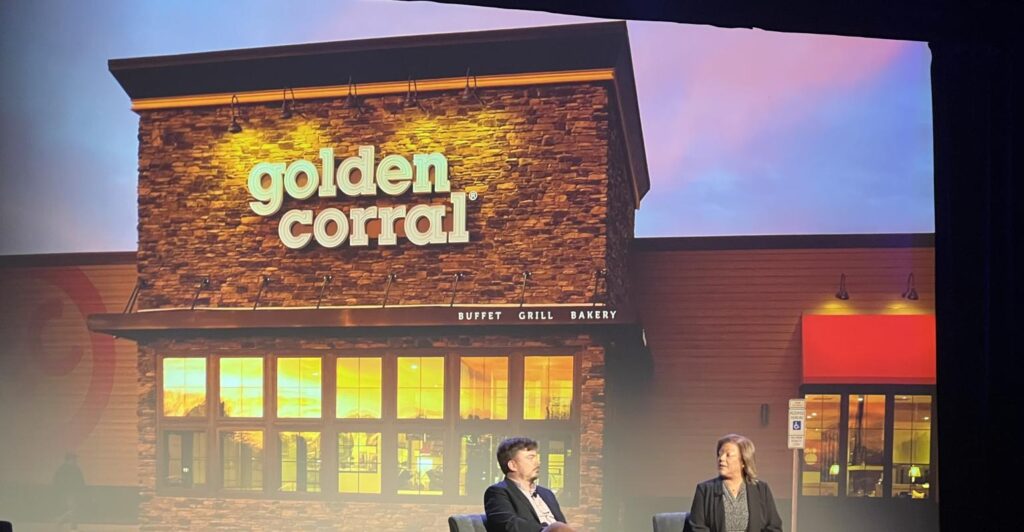How legacy restaurant brands can make technology a priority
In the ‘C-Suite in the Hot Seat’ session at FSTEC in Grapevine, Texas, operators from Golden Corral, Brix Holdings, and more discussed tech innovation.
27 September 2024
Share this exclusive content from Saladplate

Photo Credit: Joanna Fantozzi
The classics saying, “You can’t teach an old dog new tricks” doesn’t apply to a group of legacy restaurant operators that took that stage at FSTEC in Grapevine, Texas last week. Golden Corral, Captain D’s, Brix Holdings (Friendly’s, Red Mango) and The Habit Burger & Grill may have been in the industry for decades, but they are still overhauling tech stacks and prioritizing digital investments.
Here are some key takeaways from these discussions:
Replacing tech can be easier than updating
Golden Corral senior vice president and chief information officer, Dawn Gillis, said that after the pandemic “almost killed” the buffet industry, the company’s executives had to take a long, hard look at what was working and what wasn’t. One of the things on the top of their list? Outdated technology. While it might have been a challenge, Gillis said it was better in the long run to completely overhaul the tech stack.
“The front of house technology was about 15 years old, and the back of house technology is about 25 years old and didn’t exist anymore except for Microsoft,” Gillis said. “We had a big challenge ahead of us, and so we put together a massive initiative that we are running today that is basically scrapping and replacing all the technology in our restaurants. We put in an e-commerce engine that can now serve as a countertop POS.”
Be people-first and human-centric
People-first technology was a major theme at the FSTEC conference this year, and it was an especially important mantra for a company doing a complete tech makeover.
“What was really important for us was that we focused on the people that we were delivering this technology to,” Gillis said. “We started the whole process of communication to our restaurants four months before we ever went into pilot, we created an extensive change management program where we had representatives from each restaurant that were part of the change group.”
This attitude extends to franchisees as well as employees. Sherif Mityas, CEO of Brix Holdings, said it was important to create a business case for franchisees when Friendly’s overhauled its tech stack.
“At the end of the day, these are business owners, and so I’m asking them to spend $1, I need to show them a return,” Mityas said. “You can’t just sell a shiny new ball. It has to have a business case attached to it.”
Educate your guests and employees
For many of these legacy brands, having an old-fashioned dining experience is part of the charm, so introducing technology both on the customer-facing side and for employees can come as a bit of a shock.
“The key is education,”Mityas said. “It’s about, ‘how do we make your life easier?’ Something as simple as introducing pay at the table. We have grandparents that bring their grandkids, and they start to get rambunctious. You don’t have to wait for the check: You can scan, pay, and get those kids out of there before they go crazy. Utilizing technology to make that guest experience better is something young and old alike have started to adopt.”
Don’t underestimate brand size
While Habit Burger has a lot to learn and resources to mine from its parent company, Yum Brands, Mike Repetti, chief digital and technology officer with The Habit Burger & Grill, said that he thinks that their relatively small size compared to Yum’s other properties is an advantage when it comes to adapting technology.
“I think it’s definitely been a little bit of a learning both ways,” Repetti said. “I’d like to think that we bring some stuff to the table too about what it’s like to be a smaller, more nimble and agile brand during that process…. We very much believe in agility and a quick go to market strategy. We don’t want to lose that, but we also need to be able to make sure we’re building out our technology stack to be able to support thousands of restaurants as we grow.”
New tech can help find new customers
One of the most important pieces of technology Captain D’s has added over the past few years, CMO Bindi Menon said, is a hub of digital ordering channels, which includes first-party and third-party delivery, loyalty and a mobile app.
“Our digital sales have taken off,” Menon said. “Now, you know your customer better than you ever did before. Before, we could never tell who a person was coming in through the drive-thru. Now they order online, on the app, and we know exactly who they are and how often they come in.”
Menon said that although many of the first-party delivery channels are older customers who are trying out new ways of ordering, third-party delivery has brought in a new, younger crowd.
“Most of it is younger customers who are willing to pay the delivery fees, etc. for that same great two-piece fish meal,” she said.
These approaches need to resist the urge to have too many rules — regional restaurants and local franchises especially need room to be personalized and react to their audiences without doing things that will compromise the overall brand. The goal isn’t to fight for control from empowered social media audiences, but to show them that restaurant brands can add value, play along and listen to their needs. Those that do will not only earn market share, but loyalty to spare.

Source: Nation’s Restaurant News



